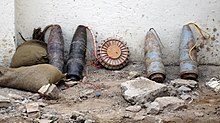
Back عبوة ناسفة Arabic Artefautu esplosivu improvisáu AST তাৎক্ষণিক উদ্ভাবিত বোমা Bengali/Bangla Improvised Explosive Device Breton Artefacte explosiu improvisat Catalan Шеш йина лелхаран хӀуманаш CE Improvizované výbušné zařízení Czech Improviseret sprængladning Danish Unkonventionelle Spreng- und Brandvorrichtung German Αυτοσχέδιος εκρηκτικός μηχανισμός Greek
This article has multiple issues. Please help improve it or discuss these issues on the talk page. (Learn how and when to remove these template messages)
|


| Part of a series on |
| Terrorism |
|---|
An improvised explosive device (IED) is a bomb constructed and deployed in ways other than in conventional military action. It may be constructed of conventional military explosives, such as an artillery shell, attached to a detonating mechanism. IEDs are commonly used as roadside bombs, or homemade bombs.
The term "IED" was coined by the British Army during the Northern Ireland conflict to refer to booby traps made by the IRA, and entered common use in the U.S. during the Iraq War.[1][2]
IEDs are generally utilized in terrorist operations or in asymmetric unconventional warfare or urban warfare by insurgent guerrillas or commando forces in a theatre of operations.[3][4] In the Iraq War (2003–2011), insurgents used IEDs extensively against U.S.-led forces, and by the end of 2007, IEDs were responsible for approximately 63% of coalition deaths in Iraq.[5] They were also used in Afghanistan by insurgent groups, and caused over 66% of coalition casualties in the 2001–2021 Afghanistan War.[6][7]
IEDs were also used frequently by the Liberation Tigers of Tamil Eelam (LTTE) in Sri Lanka during the Sri Lankan Civil War,[8][9] and by Ambazonian separatists in the ongoing Anglophone Crisis.[10]
- ^ van Rij, Armida; Bryce, Hannah; Wilkinson, Benedict; Vining, Maxine (April 2017). "Defining the device: The need for international humanitarian standards for improvised explosive device disposal" (PDF). kcl.ac.uk. King's College London. Archived (PDF) from the original on 28 January 2022.
- ^ "IEDS – Learning from History". Defence Industry Reports. 2009. Archived from the original on 13 February 2011.
- ^ Singer, Peter W. (7 February 2012). "The Evolution of Improvised Explosive Devices (IEDs)". Brookings. Retrieved 6 August 2022.
- ^ Manglik, Rohit. ESIC STENO PHASE – I 2020 | 12 Full Length Mock Test.
- ^ Cite error: The named reference
icasualtieswas invoked but never defined (see the help page). - ^ Joseph, Paul (15 June 2016). The SAGE Encyclopedia of War: Social Science Perspectives. SAGE Publications. ISBN 9781483359915.
Explosives accounted for over two thirds of the casualties in Iraq and Afghanistan, mostly caused by IEDs.
- ^ Combs, Cynthia C. (2017). Terrorism in the Twenty-First Century. Taylor and Francis. ISBN 9781317206798.
More than two thirds of combat deaths in Iraq by 2007 were caused by IEDs.
- ^ "Suicide Terrorism: A Global Threat". Pbs.org. Archived from the original on 31 December 2022. Retrieved 18 October 2009.
- ^ "13 killed in blasts, arson in Sri Lanka". The Hindu. Chennai, India. 13 April 2006. Archived from the original on 14 April 2006. Retrieved 18 October 2009.
- ^ "Cameroon Says Separatists Relaunch Attacks, IED Use After Death of Self Proclaimed General". Voice of America. 3 February 2023. Archived from the original on 27 March 2023. Retrieved 3 February 2023.
© MMXXIII Rich X Search. We shall prevail. All rights reserved. Rich X Search